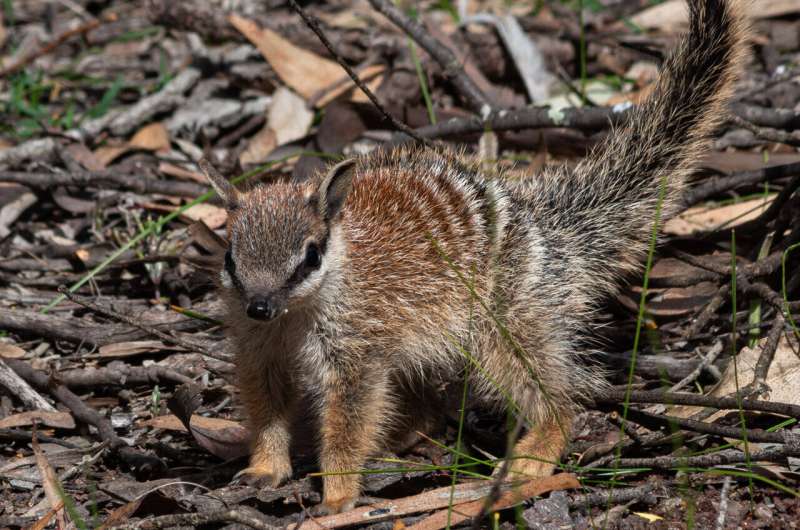This article has been reviewed according to Science X's editorial process and policies. Editors have highlighted the following attributes while ensuring the content's credibility:
fact-checked
peer-reviewed publication
trusted source
proofread
Climate change spells disaster for termite-loving numbats

Australia is known for its wonderous and unique wildlife. But, just like the rest of the world, Australia is expected to get even hotter due to climate change. This could spell disaster for many of the marsupials that call the drier regions of the country home as it may get too hot for them to handle.
To make things even more difficult, many of these marsupials are endangered thanks to habitat loss and introduced species such as domestic cats and red foxes. Therefore, finding a way to study these animals without disturbing them is critical to ensure their survival.
This realization led Christine Cooper (Curtin University, Australia) and Philip Withers (University of Western Australia) to use infrared cameras and computer models to figure out how hot it can get before the numbat (Myrmecobius fasciatus) can't take the heat. They have published their findings in the Journal of Experimental Biology.
The researchers found that high air and ground temperatures limit how long numbats can forage in the sun to ~10 minutes, after which the animals have to retreat to the shade. Under even more extreme conditions, the high temperatures of their surroundings along with the heat radiating from objects in the environment and the humidity may threaten numbat survival even in the shade.
Cooper and Withers drove around the forest paths of two Western Australian wheatbelt reserves—Dryandra Woodland and Boyagin Nature Reserve—during 2020 and 2021 to film ~50 numbats using their infrared camera. The researchers also used a portable weather station to measure the air temperature, relative humidity, solar radiation and wind speed, which they combined to get a measure of the true environmental temperature.
Numbats are the only marsupials that are solely active during the day. In fact, the team found the marsupials are in the sun 62% of the time. So, what does being in the sun do to the numbats' temperature?
Cooper and Withers measured the surface temperatures of different areas of the numbat's body when the numbats were in the sun and in the shade. Unsurprisingly, the researchers found that direct sunlight made the numbats gain heat quickly. But being in direct sunlight only accounted for 18% of the heat that the numbats gained, so the numbats must be gaining heat from somewhere else. In fact, the numbats that tried to cool off by retreating to the shade at high temperatures were still gaining heat, despite being out of the direct sun.
This led the researchers to conclude that heat from the air and ground, along with the heat radiating from objects in their environment, are the main sources of heat contributing to a numbat's risk of overheating. Because of this, the team concluded that soon, even the shade will be too hot to help numbats to keep cool.
Cooper and Withers next calculated how long the numbats could search for their food before their body temperature warmed up to 40°C (the hottest body temperature recorded for an active numbat). The team found that if the air and ground temperatures (not the temperature in direct sunlight) increased to 23°C, the numbats were only able to remain in the sun for 10 minutes before their body temperature reached 40°C.
This poses a huge problem for the numbats as their only food source is termites. Termites aren't very nutritious, so numbats have to eat large numbers of them to survive. Termites live deep underground and only move toward the surface once the ground warms up during the day. This means numbats can only feed in daytime, when the sun has warmed the ground enough for the insects to be close to the surface, within easy reach.
Thanks to climate change, the future for numbats is looking bleak. They can't forage at night when the temperature drops because their food will be too far underground for them to reach and they will be vulnerable to predators, nor can they survive in the shade if the climate keeps warming as predicted, because of the increasing heat stored in the air and rocks. Something must be done to stop the rise in global temperatures or one of Australia's iconic marsupials could become another tragic example of a creature we could have saved.
More information: C. E. Cooper et al, Implications of heat exchange for a free-living endangered marsupial determined by non-invasive thermal imaging, Journal of Experimental Biology (2024). DOI: 10.1242/jeb.246301
Journal information: Journal of Experimental Biology
Provided by The Company of Biologists



















